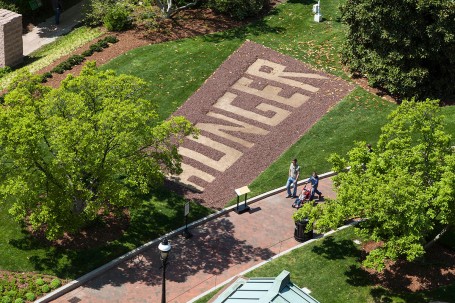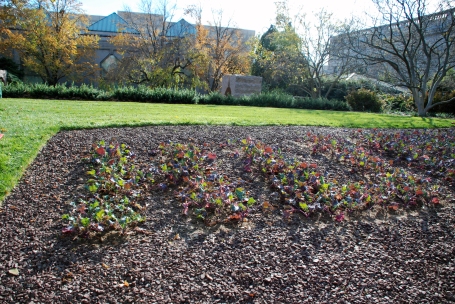Archive for November 18, 2013
“Hunger” Amidst Plenty
Hunger
Ghada Amer, (1963 – ), born in Egypt, based in New York
Earthwork in “Earth Matters”
Site-specific, 2013
Ghada Amer is one of a selected number of artists invited by the National Museum of African Art to take part in the exhibit Earth Matters: Land as Material and Metaphor by creating an earthwork in the Smithsonian’s gardens. Earthworks are large sculptural works which use earth as material, motif, and/or message. Several of these earthworks have been installed in the Enid A. Haupt Garden in the vicinity of the Sackler and African Art Museums.
Amer works in a variety of genres: painting, sculpture, film, photography, installation. In much of her work she has appropriated two media that are usually associated with domestic arts or “women’s work”: embroidery and gardening. She therefore uses thread and plants to express messages that are highly political, focusing on a range of themes, including gender roles, women’s sexuality, and human rights. In the work currently on display in the Smithsonian Gardens, Amer has chosen the subject of hunger as her topic. She thus highlights a worldwide problem at the same time that she alludes to a specific issue: the fact that politicians in her native Egypt and elsewhere prey on the hungry by promising food in exchange for votes. Bags of rice and other edibles are therefore bartered for political support.
The current earthwork began with the delineation of large letters spelling the word “Hunger” along a strip of land at the north entrance of the Haupt Garden. Once the letters were outlined as furrows, they were planted with rice. The work has therefore evolved through different stages, reflecting the initial carving of the land and the growth of the ‘crops’ growing in the designated space.
Initially, the viewer could read the word “hunger” spelled out in earth. Then, the stenciled letters were filled in with small tufts of rice plants. Over the summer months, the plants grew very noticeably, and the edible rice began to emerge. This in turn attracted birds, who saw the grain as a bonus meal. As the plants grew and became bushier, the word was ‘hunger’ became less readable. The letters re-emerged once the crop was harvested. In keeping with the original idea of crop rotation, the letters will be planted with kale, which can survive colder temperatures. During fall and winter, the letters will become greener and denser.
In “Hunger,” as in some of her other work, Amer combines medium and message, and urges us to read both the ‘writing on the wall’ and the letters on the earth.
-Annette B. Ramírez de Arellano, Smithsonian volunteer


